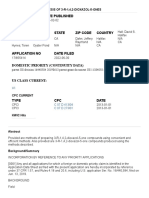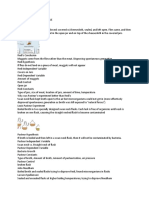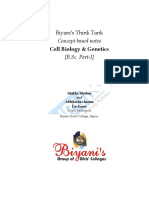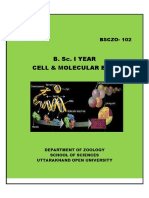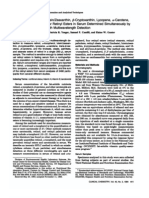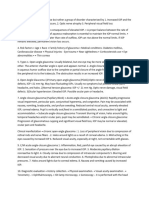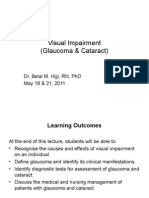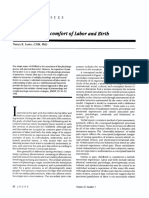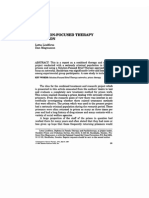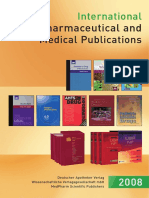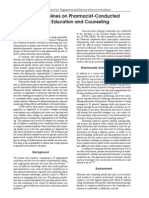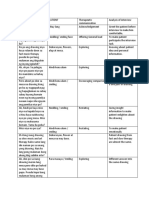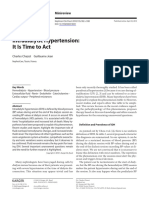Professional Documents
Culture Documents
The 35 Golden Eye Rules
The 35 Golden Eye Rules
Uploaded by
Trường GiangOriginal Description:
Original Title
Copyright
Available Formats
Share this document
Did you find this document useful?
Is this content inappropriate?
Report this DocumentCopyright:
Available Formats
The 35 Golden Eye Rules
The 35 Golden Eye Rules
Uploaded by
Trường GiangCopyright:
Available Formats
THE 35 GOLDEN EYE RULES
1.
Always test and record vision
The patient should wear any distance spectacles during eye chart
A 1mm pin hole will improve acuity in refractive errors.
testing.
2.
Never pad a discharging eye
3.
Any blurred vision requires prompt investigation
disease.
4.
5.
6.
7.
Allow it to drain.
Distinguish whether it is sudden or gradual, painful or painless.
Distorted vision (metamorphsia) may indicate treatable macular
Refer squint (strabismus) when it is detected because:
Children do not grow out of squints.
Intraocular pathology must be excluded.
Amblyopia requires early treatment.
Irritable eyes are often dry
Dry eyes: use tear supplements.
Blepharitis: check lid hygiene, remove crusting.
Chronic allergy: avoid steroids.
Ask patients with a red eye about, photophobia, reduced vision, frank
ocular pain. They may indicate a significant ocular problem such as:
Corneal foreign body
Corneal ulcer / keratitis
Intraocular inflammation (uveitis)
Acute glaucoma
Refer patients with eyelid ulcers
An eyelid ulcer may be a basal cell carcinoma.
8.
Conjunctivitis is almost always bilateral, (sooner or later)
Bacterial conjunctivitis responds rapidly to treatment.
Pre-auricular lymphadenopathy may indicate viral conjunctivitis.
If conjunctivitis is recurrent it may be due to a blocked nasolacrimal
duct.
9.
10.
A corneal abrasion should heal in 24 hours if the cause is removed
Use antibiotic ointment and a doubled pad.
Review the patient daily until the lesion is healed.
Patients with UV flash burns may need sedation.
Exclude a dendritic ulcer.
Never use steroids if herpes simplex is suspected
With herpes simplex remember:
11.
It may be relatively painless
There is often a history of recurrence and scarring
Use antivirals only
Refer the patient
Retinal detachment requires referral
12.
13.
Warning signs of retinal detachment include floaters, flashes and field
defects.
More mistakes in medicine are made by not looking than not knowing
Eye examination requires illumination and magnification.
Local anaesthetic drops in single use containers assist examination of
painful lesions.
Never use anaesthetic drops for continued pain relief.
Fluorescein staining highlights epithelial abrasions or ulcers.
Prevent corneal exposure
14.
Protect the cornea during anaesthesia or loss of consciousness
remove any contact lenses and tape the eyelids closed.
Lubricants or lid surgery are indicated in exophthalmos or facial palsy.
Steroids are dangerous
Complications of steroids include:
15.
16.
Corneal perforation with herpes simplex.
Glaucoma (open angle)
Cataract formation
Infection (fungal)
If there is a corneal abrasion, look for a foreign body
Evert and closely inspect the upper eyelid for a subtarsal foreign body
and remove it with a moistened cotton bud.
Look for ingrowing eyelashes.
Leave some foreign bodies alone
17.
18.
19.
Never attempt to remove foreign bodies that are deep central corneal,
intra-ocular or intra-orbital. Refer patients with these foreign bodies.
Consider an intra-ocular foreign body
Suspect one if there is a history of hammering or high-speed injury.
The entry wound may seem trivial.
If it is suspected, send the patient for an X-ray and refer.
Sudden loss of vision is an emergency
In the elderly, suspect temporal arteritis. With optic nerve ischaemia,
the patient will have an afferent pupil defect start high-dose oral
steroids and confirm the diagnosis by recording the elevated ESR.
Other causes of sudden loss of vision include retinal artery or vein
occlusion and macular haemorrhage
A penetrating eye injury is an emergency
Use a sterile pad with no eye drops or ointment.
20.
21.
22.
23.
Make sure the patient has nil by mouth.
If treatment is delayed, give systemic antibiotics/tetanus toxoid.
Gentle transport is essential: use analgesia, anti-emetics and sedation.
With facial and lid injuries, first exclude eye injury
Eyelid lacerations require accurate apposition of the lid margin.
Do not excise eyelid skin.
Using the ophthalmoscope
Pupil dilatation aids diagnosis.
Use tropicamide 0.5% to dilate the pupil.
The only contraindication to dilation is head injury.
The risk of precipitating acute glaucoma when dilating a pupil is low.
Irrigate chemical burns
Immediately irrigate copiously with water for 15 minutes.
Instill a local anaesthetic to evert and swab the eyelids.
Refer the patient for emergency eye care.
Optic discs are easily seen
Consider:
24.
Papilloedema if there are blurred margins and the patient has good
vision.
Optic neuritis if there are reduced vision, pain on eye movements and
an afferent pupil defect, with or without visible disk abnormality. This
is a disease of young patients.
Ischemic optic neuropathy: Painless loss of vision, disk swelling,
afferent papillary defect.
Behind the black eye there may be a blunt eye injury
If there is diplopia, suspect a blowout fracture of the orbital floor. An
X-ray or CT scan is needed.
25.
Hyphaema may indicate a severe injury. To avoid a rebleed, prescribe
rest and tell the patient to avoid aspirin. Refer the patient
Transient blindness can be serious
Causes include:
26.
27.
28.
29.
Carotid artery disease - occasionally retinal emboli are visible.
Migraine aura (often without headache).
Blindness in diabetes mellitus is largely preventable
Perform ophthalmoscopy through dilated pupil at time of diagnosis
(except in prepubertal children).
Repeat screening five years after diagnosis, then at least two-yearly.
Refer the patient if retinopathy is present.
Hypertensive retinopathy
Its presence may indicate longstanding or severe hypertension.
These patients are prone to retinal vein and artery occlusion.
Visual loss may be the presenting symptom of malignant hypertension
Headaches are rarely due to a refractive cause
Ocular causes - examine for acute glaucoma, iritis, scleritis
Extra-ocular causes - examine for papilloedema, visual field defects,
temporal artery tenderness.
Visual field defects are ocular (horizontal) or central (vertical)
Consider:
30.
Vertical - homonymous hemianopia, bitemporal field defects.
Horizontal - branch artery occlusion, open-angle glaucoma, retinal
detachment.
Pupil examination differential diagnoses:
Pupil is irregular - iritis, injury, surgery.
Pupil is dilated - Ocular trauma, third nerve palsy, adrenergic drugs.
31.
32.
Pupil is constricted - Horners syndrome, narcotics, glaucoma drops
(pilocarpine), iritis
There is an afferent pupil defect - retinal artery occlusion or optic
nerve lesion.
Cataract surgery is the most common eye operation
It is advised when symptoms are interfering with the patients lifestyle.
It is minimally invasive with local anaesthesia and day surgery.
Cataract does not recur. YAG laser capsulotomy may be required at a
later date.
Chronic open-angle glaucoma requires screening
There are no early signs or symptoms.
33.
It is familial.
Elevated intra-ocular pressure causes optic disc cupping and visual
field loss.
Treatment compliance is a problem.
Recommend routine screening for all adults older than 40. Ocular
examination for presbyopic glasses provides a good opportunity for
screening.
Acute angle closure glaucoma is rare
It is rare in people younger than 60.
vomiting.
Symptoms include pain, haloes and blurred vision, nausea and
Signs include a shallow anterior chamber, a red eye, hazy cornea and a
fixed mid dilated oval pupil.
Treatment: start pilocarpine drops and diamox, then refer urgently.
34.
Admit the following to hospital at once:
Hyphaema.
Hypopyon.
Penetrating eye injuries.
Severe chemical burns.
Acute glaucoma.
If you dont know, ask.
35.
Beware of herpes zoster ophthalmicus if the nose is involved
If the external nasal branch is involved the eye is likely to be involved.
Early systemic treatment is required.
Assessment by an ophthalmologist is essential.
References
Based on the original Golden Eye Rules by Dr John L. Colvin and reviewed by Dr.
Ehud Zamir, Director of Medical Eye Education, Royal Victorian Eye & Ear Hospital
1 November 2004
You might also like
- Anatomy & Physiology Coloring - Brain AnswersDocument5 pagesAnatomy & Physiology Coloring - Brain AnswersAliry Ro100% (1)
- Cellular Communication POGILDocument5 pagesCellular Communication POGILJiwon Shin60% (5)
- ALCHEMISTDocument4 pagesALCHEMISTaugustine abellana57% (7)
- Exercise Adherence ScaleDocument5 pagesExercise Adherence ScaleRemco Arensman100% (3)
- Cell and Molecular BiologyDocument17 pagesCell and Molecular BiologyHizzei Caballero100% (5)
- MKULTRA Briefing Book - List of Subprojects With Brief Descriptions - January 1976 PDFDocument396 pagesMKULTRA Briefing Book - List of Subprojects With Brief Descriptions - January 1976 PDFTsz Kwan LiaoNoch keine Bewertungen
- Stanford Neurodiagnostics Policies Manual 2010Document241 pagesStanford Neurodiagnostics Policies Manual 2010Felipe Kanda50% (2)
- 1 Cell Biology PDFDocument29 pages1 Cell Biology PDFRashad AlamNoch keine Bewertungen
- List of Approved Abbreviations Used in Hospitals: Filing Medical RecordDocument24 pagesList of Approved Abbreviations Used in Hospitals: Filing Medical RecordChaperone Healthcare0% (1)
- CH 10Document32 pagesCH 10Gaurav KarkiNoch keine Bewertungen
- Speech & Language Therapy in Practice, Spring 2001Document32 pagesSpeech & Language Therapy in Practice, Spring 2001Speech & Language Therapy in PracticeNoch keine Bewertungen
- 3.plant Kingdom ResonanceDocument67 pages3.plant Kingdom ResonanceEkta Manglani100% (2)
- TSLA Patent ApplicationDocument14 pagesTSLA Patent ApplicationCharles Gross100% (1)
- Bio Cell TheoryDocument22 pagesBio Cell TheoryCHLOE BEA DILLANoch keine Bewertungen
- Biological ChemistryDocument28 pagesBiological ChemistryArsilan Aziz LoneNoch keine Bewertungen
- Unit 5 Biology - Cell CycleDocument11 pagesUnit 5 Biology - Cell CycleLisa Bavaro0Noch keine Bewertungen
- History of Genetics and Genomics Narrative and OverheadsDocument22 pagesHistory of Genetics and Genomics Narrative and OverheadsRob Ettinger100% (1)
- Animal and Plant CellsDocument14 pagesAnimal and Plant Cellslea a delgadoNoch keine Bewertungen
- DERMATOLOGY MCQ (6 - 9 - 03) - POST TEST (20ebooks - Com)Document7 pagesDERMATOLOGY MCQ (6 - 9 - 03) - POST TEST (20ebooks - Com)R Ratheesh100% (1)
- Biyani's Think Tank: Cell Biology & GeneticsDocument81 pagesBiyani's Think Tank: Cell Biology & GeneticsAkshay chandrakarNoch keine Bewertungen
- The Synthetic Use of Metals in Organic ChemistryDocument177 pagesThe Synthetic Use of Metals in Organic ChemistryWhiteOak ComenziNoch keine Bewertungen
- Chemistry ProjectDocument17 pagesChemistry ProjectSurajNoch keine Bewertungen
- Cell Membrane & Tonicity WorksheetDocument5 pagesCell Membrane & Tonicity WorksheetSofia Amelia SuryaniNoch keine Bewertungen
- Request For Strategic Advice On Business Schools in Scottish UniversitiesDocument22 pagesRequest For Strategic Advice On Business Schools in Scottish UniversitiesThe Royal Society of EdinburghNoch keine Bewertungen
- Pollution EssayDocument4 pagesPollution EssayKhadijah AsrarNoch keine Bewertungen
- Bsczo 102 PDFDocument209 pagesBsczo 102 PDFajitha ajithNoch keine Bewertungen
- 2022 2023 Primary Admission List For UploadDocument183 pages2022 2023 Primary Admission List For UploadAgbo BlessingNoch keine Bewertungen
- Leo Minor ConstellationDocument6 pagesLeo Minor ConstellationMae Guanzon Saludes Cordero100% (2)
- PMLS 1 Module 1Document4 pagesPMLS 1 Module 1Jayson B. SanchezNoch keine Bewertungen
- Understanding and Teaching Students With Traumatic Brain InjuryDocument38 pagesUnderstanding and Teaching Students With Traumatic Brain InjuryJeffNoch keine Bewertungen
- Tection Thin, F3-Cryptoxanthin, Lycopene, A-Carotene,: Trans-P-CarDocument6 pagesTection Thin, F3-Cryptoxanthin, Lycopene, A-Carotene,: Trans-P-CarMaría JoséNoch keine Bewertungen
- TEXTBOOK BIOSEL and BIOMOLDocument89 pagesTEXTBOOK BIOSEL and BIOMOLTsamarah NafisNoch keine Bewertungen
- Pyschiatry MKDocument126 pagesPyschiatry MKChilufya Kalasa100% (1)
- Beheaded PDFDocument92 pagesBeheaded PDFJames JohnsonNoch keine Bewertungen
- 35 Golden Eye RulesDocument7 pages35 Golden Eye RulesJethro WuNoch keine Bewertungen
- 08-22 The Red EyeDocument6 pages08-22 The Red EyeWailea Faye SalvaNoch keine Bewertungen
- Ocular EmergenciesDocument38 pagesOcular EmergenciesHaania KhanNoch keine Bewertungen
- CD 6 OphthalmologyDocument7 pagesCD 6 OphthalmologyؤيؤييسيNoch keine Bewertungen
- GlaucomaDocument3 pagesGlaucomaPuviyarasiNoch keine Bewertungen
- Ocular Emergencies DR Wisudawan SPM - KelaskedokteranDocument22 pagesOcular Emergencies DR Wisudawan SPM - KelaskedokteranMonna Medani LysabellaNoch keine Bewertungen
- Glaucoma & Retinal Detachment-1Document29 pagesGlaucoma & Retinal Detachment-1Priya bhattiNoch keine Bewertungen
- Glaucoma 191024141130Document25 pagesGlaucoma 191024141130Broz100% (1)
- Chapter 11 Eye & Vision DisordersDocument72 pagesChapter 11 Eye & Vision DisordersMYLENE GRACE ELARCOSANoch keine Bewertungen
- Ophthalmology Emergencies - 2Document32 pagesOphthalmology Emergencies - 2navenNoch keine Bewertungen
- EyeDocument11 pagesEyeSyed Ali HaiderNoch keine Bewertungen
- NCM 116: Care of Clients With Problems in Nutrition and Gastrointestinal, Metabolism and Endocrine,, Acute and ChronicDocument18 pagesNCM 116: Care of Clients With Problems in Nutrition and Gastrointestinal, Metabolism and Endocrine,, Acute and ChronicSIJINoch keine Bewertungen
- VI (Visual ImpairmentDocument24 pagesVI (Visual ImpairmentSanishka NiroshanNoch keine Bewertungen
- 2nd Term EYEDocument8 pages2nd Term EYEhassan qureshiNoch keine Bewertungen
- Angle Closure GlaucomaDocument22 pagesAngle Closure GlaucomaDeepika LamichhaneNoch keine Bewertungen
- Ocular EmergenciesDocument26 pagesOcular EmergenciesYukianesa100% (1)
- Ophthalmic EmergenciesDocument25 pagesOphthalmic EmergenciesSameh AzizNoch keine Bewertungen
- Angle-Closure Glaucoma - UpToDateDocument9 pagesAngle-Closure Glaucoma - UpToDateElaine June FielNoch keine Bewertungen
- Ocular Emergencies: AssessmentDocument7 pagesOcular Emergencies: AssessmentradhikasreedharNoch keine Bewertungen
- Ocular Emergencies AfsDocument22 pagesOcular Emergencies AfsHengliNoch keine Bewertungen
- Determining Visual Acuity: Ocular EmergenciesDocument6 pagesDetermining Visual Acuity: Ocular Emergenciesendang kurniatiNoch keine Bewertungen
- Eye BulletsDocument3 pagesEye BulletsDonaJeanNoch keine Bewertungen
- Common Ocular EmergenciesDocument33 pagesCommon Ocular EmergenciesMaimoona AimanNoch keine Bewertungen
- Tes HenserbergDocument16 pagesTes HenserberghamzahNoch keine Bewertungen
- Drugs Used To Treat Glaucoma and Other EyeDocument38 pagesDrugs Used To Treat Glaucoma and Other Eyerenz bartolomeNoch keine Bewertungen
- Nclex EyesDocument9 pagesNclex EyesYoke W Khoo100% (1)
- Nursing Board Exam-Disorders of The Eyes! Important Notes!!Document5 pagesNursing Board Exam-Disorders of The Eyes! Important Notes!!EJ Cubero, R☤N100% (1)
- Glaucoma and CataractDocument30 pagesGlaucoma and CataractJayselle ArvieNoch keine Bewertungen
- Occular Emergencies: Presented By:-Reg No.Document21 pagesOccular Emergencies: Presented By:-Reg No.MuskaanNoch keine Bewertungen
- Is Mindfulness Useful or Dangerous For Individuals With Psychosis? - Here To HelpDocument1 pageIs Mindfulness Useful or Dangerous For Individuals With Psychosis? - Here To HelpRev NandacaraNoch keine Bewertungen
- The Discomfort of Labor: Pailz and and BirthDocument11 pagesThe Discomfort of Labor: Pailz and and BirthIhwan ZoffonNoch keine Bewertungen
- Hopkins Medicine Review Cardiology SectionDocument54 pagesHopkins Medicine Review Cardiology SectiondrsalilsidhqueNoch keine Bewertungen
- Solution-Focused Therapy in PrisonDocument15 pagesSolution-Focused Therapy in Prisonsolutions4family100% (1)
- Sri Manakula Vinayagar Nursing College: Demonstration ON Intravenous InjectionDocument22 pagesSri Manakula Vinayagar Nursing College: Demonstration ON Intravenous InjectionDeepaNoch keine Bewertungen
- CaseDocument3 pagesCasebLessy_july16Noch keine Bewertungen
- Conversion Disorder (Hysteria) : Functional Neurological Symptom DisorderDocument12 pagesConversion Disorder (Hysteria) : Functional Neurological Symptom DisorderSaman KhanNoch keine Bewertungen
- Effectiveness of StretchingDocument10 pagesEffectiveness of Stretchingاحمد العايديNoch keine Bewertungen
- Abnormal Chapter 1Document23 pagesAbnormal Chapter 1EsraRamosNoch keine Bewertungen
- 1 Snake BiteDocument8 pages1 Snake BiteMatthew Wei Hua CaiNoch keine Bewertungen
- The Lost Symbol (Indonesian Version)Document20 pagesThe Lost Symbol (Indonesian Version)YakazaNoch keine Bewertungen
- Kring Abnormal Psychology Chapter 6 Anxiety NotesDocument16 pagesKring Abnormal Psychology Chapter 6 Anxiety NotesAnn Ross Fernandez50% (2)
- Duchenne Muscular Dystrophy Handout1Document2 pagesDuchenne Muscular Dystrophy Handout1Ghanshyam GajjarNoch keine Bewertungen
- STOMATITISDocument17 pagesSTOMATITISTeguh Adi PartamaNoch keine Bewertungen
- Cleveland Clinic Quarterly-1985-Ciolek-193-201 PDFDocument9 pagesCleveland Clinic Quarterly-1985-Ciolek-193-201 PDFCésar Morales GarcíaNoch keine Bewertungen
- Catalogue CovidienDocument54 pagesCatalogue CovidienElenaIonita100% (1)
- SuctioningDocument5 pagesSuctioningNina Buenaventura100% (1)
- Premedication: AnxietyDocument2 pagesPremedication: AnxietyMuhammad Afandy PulualaNoch keine Bewertungen
- Sri Lakshmi Medical Centre and Hospital: 18/121 MTP Road, Thudiyalur, Coimbatore - 641 034Document49 pagesSri Lakshmi Medical Centre and Hospital: 18/121 MTP Road, Thudiyalur, Coimbatore - 641 034dhir.ankur100% (1)
- ToradolDocument2 pagesToradolAdrianne Bazo100% (1)
- ASHP Guidelines On Pharmacist-ConductedDocument3 pagesASHP Guidelines On Pharmacist-ConductedGirba Emilia100% (1)
- Mark NpiDocument2 pagesMark NpiBianca Ysabelle RegalaNoch keine Bewertungen
- Assessment Nursing Diagnosis Planning Intervention Rationale EvaluationDocument3 pagesAssessment Nursing Diagnosis Planning Intervention Rationale EvaluationAlyNoch keine Bewertungen
- Intradialytic Hypertension Time To Act 10Document7 pagesIntradialytic Hypertension Time To Act 10Nia FirdiantyNoch keine Bewertungen
- Hiv in PregnancyDocument52 pagesHiv in PregnancyKirandeep ParmarNoch keine Bewertungen
- Positive Cognitive Behavioral Therapy: January 2016Document11 pagesPositive Cognitive Behavioral Therapy: January 2016Cristian AstoNoch keine Bewertungen












